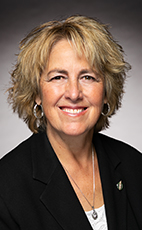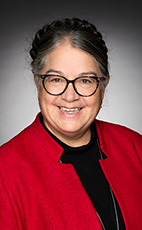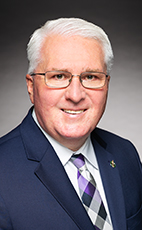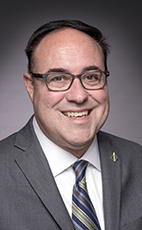44th Parl. 1st Sess.
September 16, 2022 10:00AM
- Sep/16/22 10:01:54 a.m.
- Watch
It being 10 a.m., pursuant to order made on Thursday, September 15, the House will now proceed to Statements by Members concerning the passing of Her Majesty Queen Elizabeth II.
The hon. member for Fleetwood—Port Kells.
39 words
- Hear!
- Rabble!
- add
- star_border
- share
- Sep/16/22 10:09:20 a.m.
- Watch
Madam Speaker, it is an honour for me to rise today, as parliamentarians on all sides of the House remember, honour and pay tribute to Her Majesty Queen Elizabeth II, our sovereign, our head of state, commander-in-chief of the Canadian Armed Forces, a global leader, a mother, a grandmother and a great-grandmother.
I want to start, as a member of Her late Majesty's Privy Council and a member of Parliament, by expressing my deepest sympathies to the royal family. While the Queen was an icon to people around the world, possibly the most recognizable figure, to them she was a mother. She was leader of the family, and she was someone they could go to in good times and bad.
I also want to pledge my allegiance, as Canada does within its constitutional monarchy, to our new King, Charles III. Long live the King.
There have been many great reflections on Her Majesty in the last week. We are still in a bit of shock, despite the fact that her 70 years on the throne led to us knowing that this day would come. It is still a very difficult day, so I looked to two of the greatest Britons for inspiration, one being the Queen, the longest-serving monarch and a great leader, the other being their longest-serving member of Parliament. At 64 years in Parliament, Sir Winston Churchill did not reach the Platinum Jubilee levels of the Queen, but he was her first prime minister, and he had remarkable thoughts about the Queen that I will share with the House today.
In fact, in 1928, Winston Churchill met Princess Elizabeth at two years of age, at Balmoral Castle. In a letter to his wife, Clementine, he said, “There is no one here at all except the Family, the Household & Princess Elizabeth—aged 2. The last is a character. She has an air of authority & reflectiveness astonishing in an infant….” At that time, given a later abdication, Winston Churchill never would have thought that that young princess would be his queen and he, her first prime minister.
What is more remarkable is the next speech I am going to give. Canada, really the leader within the Commonwealth, particularly in the modern age, was pushing within the Commonwealth to end apartheid and pushing for aid, security and trade around the world through our common bonds in the Commonwealth.
In 1953, just days before the Queen's coronation, at a gathering of the Commonwealth Parliamentary Association at which both the Queen and Canada were present, Winston Churchill said, “Here today we salute fifty or sixty Parliaments and one Crown. It is natural for Parliaments to talk and for the Crown to shine.” He went on to say, “Well do we realize the burdens imposed by sacred duty upon the Sovereign and her family. All round we see the proofs of the unifying [force] which makes the Crown the central link in...our modern changing life, and the one which above all others claims our allegiance to the death.”
The Queen did shine with a remarkable brilliance for over 70 years on the throne, not just in the United Kingdom, but in Canada and around the world. She was the central link for our parliamentary democracy for almost half of our time as an independent country.
I would now like to say a few words in French, one of the two founding languages of our country. Interestingly enough, the greatness of the Quebec nation was enshrined in our Constitution and guaranteed by the Crown. Throughout our country's history, the Quebec nation has faced challenges and discrimination. Despite that, Quebeckers have grown strong and proud. Today, we have a nation that is proud of its language, culture and identity thanks to the people of Quebec, the constitutional monarchy, and the Constitution of a country founded by two peoples in partnership with the first nations.
I am proud to stand in the House of Commons and speak in French, thanks to my service in a bilingual federal institution. Canada is not perfect. There are challenges facing francophone minority communities in some parts of the country.
We live in the best country in the world, thanks to our history and our two peoples. North America is home to an island of 7 million francophones in a sea of 600 million Anglophones, and we neighbour the most influential nation in the world, the United States. However, the Quebec nation and French-speaking communities are thriving from coast to coast to coast. That is incredible. We must remember that and celebrate it.
The Queen shone when she was here for 22 official visits, meeting millions of people. She said this in the nearby chamber for her Silver Jubilee in 1977: “My happiest memories of our travels throughout Canada have been these individual contacts, which have revealed the enormous strength and astonishing diversity of this nation.”
She was the mother of all people, a title given to her in the 1950s by the Coast Salish people in British Columbia, commander-in-chief of the Royal Canadian Mounted Police, and the honorary captain, honorary air commodore or honorary colonel of 16 regiments; 34 of our commissioned ships are Her Majesty's Canadian ships, and I wear the tie today of one institution, Royal Military College, that was given her seal.
One of those regiments is something that touched this Parliament not long ago, the Argyll and Sutherland Highlanders of Canada, Princess Louise's. The Queen was their honorary colonel. Going back to 1951, when she was a princess, she visited then. She visited again in Hamilton in 2002 to bestow new colours on the regiment.
However, it is not in celebration that the Queen's leadership was evident. It was in 2014, when one of their soldiers was killed not far from here, at our National War Memorial. The Queen's letter to the regiment was the first to arrive. Her wishes were expressed to the family of Nathan Cirillo and to the regiment. Months later, she invited members of the regiment to her private apartment at Buckingham Palace, not only to express sympathies but also to inquire as to how the son and family of Nathan Cirillo were doing.
These were not honorary titles that the Queen just took without caring about them. She was deeply committed to every institution that she was the central link to, as Winston Churchill once said. She was the commander-in-chief of the Canadian Armed Forces. My first oath to the Queen was given in 1991, at the age of 18, when I swore an oath of allegiance. I have had that honour many times, as a member of Parliament and in 2015, when I joined what was then Her Majesty's Privy Council, that central link in these institutions upon which our rich parliamentary democracy is built. She is the central link to the great mother, Queen Victoria, and our rights and responsibilities and the constitutional rights for indigenous peoples in this country. She is a patron and has been a supporter of innumerable causes in her 22 visits to this country.
The Queen's first speech from the throne in person in Canada was years after the creation of NATO, and she has been there as our sovereign as our country grew in the modern age, from NATO to the opening of the St. Lawrence Seaway, Expo 67, the Montreal Olympics and, of course, the 1982 patriation of Canada's Constitution, which in many ways was the full-circle moment for the Queen to help deliver the modern Canada on the world stage and showcase our commitment to the fundamental rights of all of our citizens in the charter. The Queen said on that day, April 17, 1982, just outside where we are today, “I am pleased and proud to be with you today, not only to celebrate the patriation of the Constitution, but to rejoice in Canada, its past, its present and its future.”
Today, let us rejoice in the life of service and the leadership of Her late Majesty Queen Elizabeth II. Let us remember where she shone on her visits here and around the world, and let us remember that that central link of our constitutional monarchy has provided stability and helped build great institutions upon which we rely as Canadians. In this Parliament, we can celebrate, debate and discuss the future of this country, knowing it is rooted in the fertile soil of our Constitution and our roots.
Today, we say, “The Queen is dead. We celebrate and honour her life. Long live the King.”
1464 words
- Hear!
- Rabble!
- add
- star_border
- share
- Sep/16/22 10:20:26 a.m.
- Watch
Madam Speaker, as a woman myself, I feel compelled to pay tribute to the Queen for the woman she was.
I would like to begin by expressing my most sincere condolences to Her Majesty's family and every Commonwealth citizen saddened by her death.
Today I would like to talk about the woman who bore the great title of Queen of 15 Commonwealth countries and head of the Commonwealth, a role she fulfilled to the very end of her life.
Throughout her 70-year reign, she performed her duties with dignity, strength and composure while also carrying out her roles as wife, woman, mother, grandmother and great-grandmother. During her reign, the Queen demonstrated remarkable agility in wearing all the hats a woman must wear on a daily basis. Let us not forget that she reigned during a time when women fought very hard for recognition of their rights.
She encountered many a storm throughout her life, but she always kept a steady hand on the tiller. She honoured all her responsibilities with devotion. She always recovered from setbacks with her characteristic grace and strength. She set an example for us all.
We will always remember her as a strong, bold woman. Few women will ever leave as indelible a mark on history as Her Majesty Queen Elizabeth II. May she rest in peace.
224 words
- Hear!
- Rabble!
- add
- star_border
- share
- Sep/16/22 10:22:40 a.m.
- Watch
Madam Speaker, I am very pleased to rise today. I know that much has been said over the last day and will continue to be said this morning in this place. I am glad and honoured to be here to lend my thoughts about the remarkable life and service of Her Majesty Queen Elizabeth II on behalf of the people that I represent in Barrie—Innisfil.
I want to begin by expressing my deep and sincere condolences to the family of Her Majesty and to King Charles. I hope they are finding great comfort with the outpouring of love and respect on such a grand scale by all of her, and now his, loyal subjects in every part of the Commonwealth and, indeed, in all corners of the world.
The Queen's passing, frankly, has been like the loss of a family member, as it should. Her Majesty is the only monarch a generation-plus has known, and we have experienced every moment of her life, every joyous occasion, every triumph, every sorrow and every challenge.
I looked back at just some of the historical events that our Queen has presided over in her 70 years of reigning the Commonwealth, and they are quite remarkable. Much has been said over the last couple of days about that, but it is important to highlight that her service did not just start with her coronation in 1953. It started well in advance of that, in 1945, when the Queen joined the British military when she turned 18. She joined the Auxiliary Territorial Service, ATS, as a mechanic during World War II. The Queen made a state visit to the United States, where she addressed the nations of the United Nations General Assembly, on behalf of the Commonwealth, and then she opened the 23rd Canadian Parliament, becoming the first monarch in Canada to open a parliamentary session. She was the first monarch to visit West Germany.
There were so many disasters, so many joys and so many triumphs. I am thinking back to 1966 and the Aberfan disaster, which led, eventually, to the 1969 Mines and Quarries Act.
In 1975, Queen Elizabeth II and her husband, Prince Philip, paid their first visit to Hong Kong. This was the first visit to Hong Kong by a reigning British monarch. As has been mentioned, she opened the 1976 Summer Olympics in Montreal. In 1979, Margaret Thatcher became the first female prime minister of the United Kingdom, which meant that the people of Great Britain had, effectively, two iron ladies.
In 1982, on April 17, Queen Elizabeth II and then prime minister Pierre Elliott Trudeau, as well as then minister of justice Jean Chrétien and André Ouellet, the then registrar general, signed the proclamation that brought the Constitution Act of 1982 into force. The proclamation confirmed that Canada had formally assumed authority over its constitution, the final step to full sovereignty, not far from where we are today.
In 1991, she addressed a joint meeting of the U.S. Congress, following the coalition victory in the Gulf War. In 2015, she became the longest-reigning British monarch, surpassing her great-great-grandmother, Queen Victoria.
There has been sorrow, much sorrow, including the loss of her beloved husband of 74 years, Prince Philip, in 2021. Of course, this year, the Queen celebrated her Platinum Jubilee, after a record of 70 years on the throne.
As the most widely travelled Commonwealth monarch, Queen Elizabeth II made 22 official visits to Canada and seven to Toronto. Her first was in 1951, as Princess Elizabeth, where she visited in place of her father, who was ill, and her last was in 2010.
Through everything, she did it with strong determination, grace, humility, wisdom, loyalty and, above all, selfless service.
She was also modernizing the monarchy, bringing it into the 21st century. Think for a minute how communication and technology changed over her lifetime and how she ably adapted to that, from that first radio address pledging herself to a life of service, to a recent video with Paddington Bear on the occasion of her Platinum Jubilee. She was always there to communicate and give comfort in good times and in bad.
We will miss her steady hand and her confidence that no matter how bad things are, they will be better. For me, Her Majesty's eternal optimism and humility is what I will miss the most.
I am sure by now, since the Queen's passing, millions of people around the world have seen that Paddington Bear video produced just three months ago for the Platinum Jubilee concert. It was one of the last times any of us saw the Queen before her passing because she was just not fit enough to attend the concert.
It is stated in a recent BBC article that the video was written by some of the people who worked on the Paddington films. They said, “We knew Paddington and the Queen stood for, and still do stand for, certain similar values—the idea that, be kind and polite and the world will be right.” That was said by co-writer James Lamont recently in a BBC Radio 5 interview.
He also said:
It just felt very natural that those two could share a space together. They would both welcome each other, because they're both cut from the same cloth.
We also thought there was some inherent comedy in the idea of Paddington, who we know is a bit of a klutz and a bit of a bull in a china shop at times—putting him in Buckingham Palace in front of the Queen, where etiquette and behaviour are obviously paramount.
Little did anyone know that the video produced through the magic of television would provide so much comfort to so many in this time of grief, but it has. There is a scene in the video where the clumsy bear, after squishing his lunch, reaches into his hat and offers Her Majesty his marmalade sandwich, his favourite, saying he always keeps one for emergencies, to which she replies, after reaching into her purse, “So do I...for later.” Today, so do I, for later.
At that moment, they came together and embodied so many of the values that the world needs right now: kindness, toleration, being kind to strangers and politeness, things that are about one's character. It is those values that Her Majesty Queen Elizabeth embodied throughout her whole life, no matter how good or how bad things were. That is what made her so special and it is what we should all strive to be.
Today, I pledge my allegiance to King Charles III. As I conclude, I will leave everyone with the words of a clumsy, lovable bear who became an unlikely royal mascot, who has been a source of comfort and who has brought a smile to people around the world during this difficult time, words that many of us would have loved the chance to say to Her Majesty: “Thank you Ma'am, for everything.”
1191 words
- Hear!
- Rabble!
- add
- star_border
- share
- Sep/16/22 10:36:55 a.m.
- Watch
Madam Speaker, it is an honour to rise today and pay tribute to Her late Majesty Queen Elizabeth II on behalf of the people of Flamborough—Glanbrook and the greater Hamilton area. However, I do so with a heavy heart. First and foremost, we, her loyal subjects, offer our most sincere condolences to the entire royal family. May strength be given to all of them at this time.
In the next few minutes, I would like to share some of the thoughts that people in the Hamilton area have offered me in the past week as they grieve the loss of our Queen.
Her late Majesty officially visited Hamilton three times during her lifetime: first, as Princess Elizabeth, in 1951; then twice as Queen, in 1959 and 2002. Each time it was an honour for our city to receive her. Her late Majesty was colonel-in-chief of the Argyll and Sutherland Highlanders of Canada, a regiment based in Hamilton.
The hon. member for Durham just spoke about the very special bond the Queen had with the Argylls and the Argylls had with the Queen, and her very deep caring on the tragic events of 2014 with the shooting of Nathan Cirillo of Hamilton. The Argylls featured prominently in all her visits, most notably in her Golden Jubilee year, 2002, when she presented them with new colours at a large public ceremony at what was then Copps Coliseum in downtown Hamilton. While the ceremony was all service and duty for which she was known, her charisma shone through while she spoke to the overflowing crowd, and in her individual conversations with veterans, her broad smile always told the story.
Please allow me to convey the reflections of the people of Flamborough—Glanbrook and beyond. Over the course of the week, constituents have shared their recollections of their encounters with the Queen, whom they love so much. One lady has a View-Master disc, and some of us will remember what those are, of the Queen's coronation. She holds this in her memory and treasures it very much this week. Another constituent remembers meeting the Queen as a Brownie under the Girl Guides in Edmonton.
Treasured photos are on display or have been taken out from the drawers in which they have been tucked away. They are of grandmothers, uncles and aunts dressed in their Sunday best to be presented to Her late Majesty. For so many, the Queen's annual Christmas message is a warm memory; it is often there where her best qualities of compassion, charm and wit were most evident.
I have also heard from descendants of United Empire Loyalists and they have a natural bond and a natural affinity with the monarchy. They are so proud that Queen Elizabeth II upheld that institution with such grace, composure and elegance, during what were often trying times for our world.
In addition, those affiliated with the Argylls continue to express their eternal gratitude to Her late Majesty for visiting each time she was in Hamilton, for caring so deeply at the tragedies they experienced and for making them such an important part of her life as their commanding officer.
If I may add my own memories to those of the constituents whom I have been honoured to represent and speak on behalf of here, I was also blessed to meet Her Majesty in 2002. It was a 12-day Golden Jubilee tour of Canada during which she was celebrating 50 years on the throne.
The Government of Ontario at that time held a large royal reception at the National Trade Centre in Toronto. People lined up on both sides of the aisle as the royal couple made their way around the room. While my own time with our beloved Queen was not more than a quick hello because on the opposite of the aisle there were people with horses, and she was naturally drawn to speak to those people to see the horses, as that was one of her loves, I did have a more fulsome conversation with Prince Philip, and he exuded all the charm that he was also known for.
In fact, the tie I am wearing today is the tie I wore that day in 2002. I bought it especially for the royal visit, and it has remained one of my favourites ties, even more so now. This is the first time I have worn it since her passing, and I will continue to think of her, as I do today, every time I wear it.
I will close with the thoughts of a successful woman and leader from Hamilton who remembers the Queen for much more than the service and duty for which she has been so rightly credited. This woman, now in her early forties, is leading an important organization in her chosen profession, and for her, the Queen has always been a role model all of her life, a woman in a powerful leadership role that she could look up to at a time when that was so rare. I know this same point has been made by members on both sides of the House already in the past couple of days, but I think it bears repeating and amplifying.
For this individual, and doubtless millions of girls and young women, the Queen was an inspiration. As head of state, her constant presence told them that they could dream big and do anything. Therefore, even though she was born into this royal role, and she chose to define it from the outset as lifelong service and duty, she broke that glass ceiling at a time that it just did not happen. It is that major accomplishment that has stuck with the young woman who I spoke with the other day, and it is the enduring memory of her late Majesty Queen Elizabeth II. We will miss her dearly.
In a world where the pace of change accelerates by the day, she was a constant. We now look to his Majesty King Charles III, to whom I pledge allegiance, to carry on that legacy.
May God save the King. May God continue to bless Canada.
1034 words
- Hear!
- Rabble!
- add
- star_border
- share
- Sep/16/22 10:44:19 a.m.
- Watch
Madam Speaker, I rise in this place during this solemn time to express my deepest sympathies and condolences to the members of the royal family and to all those in the Commonwealth as we collectively mourn the passing of Her Majesty Queen Elizabeth II. As the member of Parliament for the riding of Niagara Falls, which includes the city of Niagara Falls and the towns of Niagara-on-the-Lake and Fort Erie, it is my sincere honour to be able to stand in my place today to pay tribute to our beloved Queen after her death on September 8 at 96 years of age.
For 70 incredible years, Her Majesty Queen Elizabeth II was Canada's head of state. In fact, her tenure lasted for 45% of Canada's 155-year history. Given this, she oversaw many of our country's most significant events of the 20th and 21st centuries. She reigned for an incredible period of time, and did so with dignity, grace, honour and a profound sense of duty and service.
For many, their understanding of monarchy and the Queen and her relationship to Canada is limited to such things as portraits adorning walls of government buildings or recognizing her face and her name on our currency, but in a real sense, it is much more profound than that.
Peter McNally, a retired McGill University information studies professor, recently spoke with CTV News and said, “Today, the monarchy is the living embodiment of Canada's parliamentary tradition.”
This parliamentary tradition is one which can trace its roots back over 800 years. The monarchy in Canada, as represented by the Queen for 70 years and as currently represented by King Charles III, is fundamental in our everyday lives and way of life in Canada, even if it is not explicitly apparent on a day-to-day basis. In fact, many Canadian leaders have acknowledged the importance and continued relevance of the Crown in our daily lives.
In 1993, the Hon. Mike Harris, former premier of Ontario, noted:
The Oath to the Queen is fundamental to the administration of law in this country. It signifies that, here in Canada, justice is done—not in the name of the Prime Minister, or the mayor, or the police chief, as in totalitarian nations—but by the people, in the name of the Queen. Rather than being offensive, I submit that it’s one of the hallmarks of our society that attracts people to Canada.
A year before that, the Right. Hon. Brian Mulroney, former prime minister of Canada, stated:
The Crown has symbolized a continuity in the values of decency, fairness and equality before the law that have made this country great. And no Sovereign has served her Canadian subjects with more grace, more concern and more goodwill than has Queen Elizabeth II. The Queen’s sense of duty, her courage, warmth and her honour are known and appreciated by all Canadians.
In an ever-evolving world and in a sea of constant change, we could always look to Queen Elizabeth II to find our balance, stability and our courage. She was always a beacon of hope in dark times, comforting and a calming presence. Her leadership was constant and steady, fulfilling the promise she made on her 21st birthday while on a trip to South Africa with her family when she indicated:
I declare before you all that my whole life whether it be long or short shall be devoted to your service and the service of our great imperial family to which we all belong.
During her life, Her Majesty visited Canada more than 20 times between 1951 and 2010. She visited Canada more than any other nation in the Commonwealth. In fact, her first visit to Canada included a visit to my beautiful riding of Niagara Falls just three months before she would ascend to the throne. At that time, given her father's declining health, her tour carried an official proclamation should the King pass away while she was on tour.
According to the Niagara Falls Public Library archives, during her visit to Niagara, she described the views of Niagara Falls as “magnificent” and “tremendous” as she stood at the railing of the Canadian Horseshoe Falls. It is estimated a crowd of 150,000 people in Niagara Falls cheered the royals throughout their visit before they boarded the royal train to continue their tour across Canada.
In February 1952, her father King George VI passed away and Princess Elizabeth immediately assumed the throne as our Queen, and she has been our Queen ever since. For millions upon millions of Canadians, myself included, Queen Elizabeth II was the only head of state we had ever known, until now, upon King Charles III assuming the throne.
Queen Elizabeth's next visit to Niagara Falls took place in 1973. This was her first visit as Queen. She was on tour with her husband, Prince Philip, to open the renowned Shaw Festival in Niagara-on-the-Lake and to visit nearby Fort George, an important military post from the War of 1812.
One constituent recently shared with the St. Catharines Standard his memories of the Queen's Niagara-on-the-Lake visit in 1973. Ken Bridgman of St. Davids in Niagara-on-the-Lake wrote that he was the general manager of the Pillar and Post inn at the time of the royal couple's visit. Mr. Bridgman, along with MPP Robert Welch and John Drope, the owner and founder of the Pillar and Post, met with the royal couple as they entered the inn. They both had the privilege of escorting the royal couple to their rooms.
During the walk, Mr. Bridgman recalls the royals expressed interest in the origins of the old building, the impact of the Shaw Festival on tourism and employment in the town, the history of Niagara-on-the-Lake, and other current events. He called the royal couple "engaging” and noted that they were “most complimentary” of their rooms.
In the same article of memories and recollections of royal visits to Canada, my predecessor, the Hon. Rob Nicholson, also made a submission that was published. Mr. Nicholson served as the member of Parliament for the Niagara Falls riding for over 24 years. He wrote that he and his wife, Arlene, and their daughter, Christine, had the privilege of meeting the Queen at the Royal York Hotel in Toronto in June 2010, while he was serving as Canada's justice minister and attorney general. They had a beautiful picture taken. He noted that the Queen was genuinely warm and friendly and it was quite evident that she loved being in Canada.
Given its immense beauty and rich history in nation building, Niagara has had a strong track record of attracting royalty to the area. Other visits happened long before Queen Elizabeth was even born. The first visit was as early as 1860, when the first planned illumination of Niagara Falls took place in honour of the visit of His Royal Highness the Prince of Wales, later King Edward VII . Nineteen years later, in 1879, Niagara Falls was illuminated again in honour of a visit of Princess Louise and her husband, the Marquis of Lorne, the fourth Governor General of Canada.
In the fall of 1901, the Duke and Duchess of Cornwall and York, the future King George V and Queen Mary, visited Niagara Falls. Since that time, Niagara Falls has been pleased to play host to visits by the Prince of Wales, the future King Edward VIII, in 1919 and 1927; Their Majesties King George VI and Queen Elizabeth in 1939; the Duchess of Kent in 1954; Her Royal Highness Princess Margaret in 1958; Princess Diana, Prince William and Prince Harry in 1991; and Her Royal Highness Sophie, The Countess of Wessex, in 2012.
Queen Elizabeth made her final trip to Canada in 2010 at the age 84. While Niagara is a popular destination for the royals, we are all going to greatly miss the visits from Her Majesty Queen Elizabeth II. Her memory will always live on and be treasured by all those who appreciated her.
Through the remainder of the 10-day mourning period, between 10:30 and midnight in the eastern time zone, Niagara Falls will be illuminated in royal blue in tribute to Her Majesty Queen Elizabeth II. This tribute will happen nightly and conclude on the date of her funeral, September 19. I invite all Canadians and international visitors who are able to come and witness it as a way to pay their respects in her memory.
Niagara Falls holds many important connections to the royal family and Her Majesty Queen Elizabeth II. We will always remember her, and we will always treasure those memories of her and her devoted service to the monarchy, the Commonwealth and to Canada. It has been a great honour for me to pay my respects to all those mourning our great loss through this tribute to Queen Elizabeth II.
May you rest in peace, Your Majesty. Long live the King.
1528 words
- Hear!
- Rabble!
- add
- star_border
- share
- Sep/16/22 10:53:44 a.m.
- Watch
Madam Speaker, before I start, I want to underscore the horrific violence that members of the community of James Smith Cree Nation and the town of Weldon suffered just a few days ago. That pain and suffering in those communities is difficult to describe for those families. A number of us have expressed over the course of the last few days, for all the victims and their families, that they are in our hearts and in our minds at this time.
We are speaking of the legacy of Queen Elizabeth II. It is difficult to encapsulate the life of someone who had such an impact on so many people in a few minutes even in this place. We are sometimes challenged to really encapsulate a life that had so much impact on so many of us. My colleagues have all spoken with great eloquence. What I would like to do today is relay more of a personal impression of Queen Elizabeth II.
There is the institution, of course, and ultimately at some point there will be discussions around that institution, but there is, above all, the person. The person, Queen Elizabeth II, Her Majesty, was somebody who was very engaged, who brought immense stability to our parliamentary system and to our democracies, and showed incredible dedication.
Queen Elizabeth II visited the community of New Westminster three times through her long reign. She visited the community of Burnaby twice over that same period. I will mention more specifically some of the reflections of people in my community in a moment, but each time she came, she was fully engaged and provided a remarkably memorable visit in both New Westminster and in Burnaby.
Before I get to those personal reflections, I want to talk about the great gifts that Queen Elizabeth II provided us. Foremost is the stability that she brought through her long reign. It is the longest reign by a monarch in recent times; 70 years. We sometimes take that for granted, the seamless passage from one institution to the next, the seamless passage of the monarchy, the Queen passing away and within hours King Charles III being crowned.
We had the stability that came from having a head of state that welcomed and inaugurated 15 governments in the United Kingdom and a dozen governments through her representative here in Canada. We sometimes take for granted that stability of passage, that seamless passage from one government to the next, democratically elected, her continuing reign as head of state and even the seamless passage from the head of state, as she passed away, to her successor.
This is not something we should take for granted, particularly in this day and age. We only have to look at the chaotic violence on January 6, 2021, in the United States from a man who promotes despotic values. That chaotic violence is a strict contrast and a wake-up call for us to never take for granted the stability that Queen Elizabeth personified passing from one government to the next, always respecting those fundamental democratic values that we all hold dear.
Queen Elizabeth II really embodied the spirit of dedication. I think the best example, as so many of my colleagues have said over the past 24 hours as we have been paying tribute to her in this House of Commons, is the fact that 48 hours before her death, at a time when surely she was aware that her time, her hours were numbered on this earth, she still was able to welcome the new Prime Minister of the United Kingdom, Prime Minister Truss. That was done 48 hours before she passed. That dedication, putting her role and the importance of her position before all else, is something that a number of people have commented on as well.
It is important to note that this continuity is something that comes from the presence of Queen Elizabeth II in so many aspects of her life. It is also important to note, primarily, that in the many comments that have followed her passing, new Canadians, who have taken an oath of citizenship to her, have often been, I think, the strongest in terms of providing comments and talking about the person of Queen Elizabeth and her impact on their lives. However, above all, she was engaged, and I want to relate a personal anecdote.
In 1971, on one of her numerous visits to New Westminster, my classmates and I at the time, at nine years old, danced for the May Day festivities in front of Queen Elizabeth II and Prince Philip. All of us were nervous before we got up to dance, and afterward, all of us thought the Queen had been watching us. Just last weekend, I sat down with a number of my classmates from that time: Becci Dewinetz, Debbie née Cooke, and Kathy née Gifford. All of us, even now 50 years after the event, felt that the Queen was very much focused on us during that event, and this is something that is absolutely part of people's reactions to Queen Elizabeth and her engagement with people wherever she went in the Commonwealth.
Over the last few days at Century House, which was actually inaugurated by Princess Margaret in 1958 in New Westminster, books of condolences have been signed by my constituents. When we inaugurated the first day last Monday, there was a lineup right out the door, and people have been coming throughout the week to sign a book of condolences to send messages of condolence to the royal family.
There was Lorraine Holmes, who is in a motorized wheelchair and has a half-hour trek to get to Century House. She felt it was so important to sign that book of condolences. She wanted to pass on her condolences and her memories of Queen Elizabeth II.
There was Rachel and many people from across the Lower Mainland. It took Rachel two hours by bus from Tsawwassen to come to New Westminster to sign that book, and we have had people from throughout the Lower Mainland lined up to sign the book and express their condolences.
I want to read one passage from Colleen Vogler and her family:
“Thank you, Your Majesty, for being the best example to the world of how to live one's life as a leader in monarchy, a mother, a wife, a grandmother, a great-grandmother and a woman. You were wise, intelligent, devoted, kind, loving and had a terrific sense of humour. You kept the world in sync so that you had them keep calm and carry on. There's one more angel in heaven. There's one more star in the sky. Blessings, hugs to the family and all who knew her. God bless the Queen. Colleen Vogler and family.”
The same expressions were expressed by many as they came to sign the book of condolences.
There is no doubt, as the member for Burnaby South said in his speech yesterday, that there is now an important role for King Charles III to play in reconciliation with indigenous peoples. I repeat the call of our leader, the member for Burnaby South, that King Charles III must strive for reconciliation with indigenous peoples and look to a royal proclamation of reconciliation. It is fundamental and must be a priority for our new monarch.
I am reminded of a phrase from Thornton Wilder, who said, “The highest tribute...is not grief but gratitude.” We are profoundly grateful for the service of Queen Elizabeth II, for the stability she brought throughout her long reign through her dedication and devotion, expressed until hours before her passing, and for how engaged she was with people in her visits to my communities of New Westminster and Burnaby, but also with everyone she met throughout her long reign.
We are grateful for all that she contributed to our democracy and to the institution. She will be missed.
1335 words
- Hear!
- Rabble!
- add
- star_border
- share
- Sep/16/22 11:09:25 a.m.
- Watch
Madam Speaker, I rise today to pay homage to Her late Majesty Queen Elizabeth II, who lived a life of selfless service to her people here in Canada and across the Commonwealth.
For 70 years, she reigned as sovereign with unparalleled grace, dignity and prudence, which was carried at a standard so high that it was uniquely hers. Through times of tragedy and hardship or joy and renewal, she was there, like the North Star at night or the rising sun in the morning, a quiet unwavering constant.
With her supreme prudence, Her late Majesty knew exactly when to step forward and deliver the exact message that people needed to hear. This started at the age of 14 for her, as a child, when she was broadcast across the Commonwealth to reassure children, particularly the British during the Blitz, that they would be victorious and it would be up to their generation to rebuild the world, right through to her pandemic address when she reassured us all that we would meet again.
I stand here as the member of Parliament for Leeds—Grenville—Thousand Islands and Rideau Lakes, a riding that has a proud history as United Empire Loyalists and had the great honour and privilege of hosting Her late Majesty in 1984. As a brief aside, that is the year I was born, so I was not in attendance at this historic event.
She visited Fort Wellington in Prescott for a demonstration by the War of 1812 re-enactors. Many locals went out to greet their Queen, and she enjoyed her first time at Fort Wellington so much that she decided to stay well past her scheduled time to inspect the formation of the soldiers. When the soldiers at the demonstration fired the large cannon at the fort, as they love to do, Her late Majesty reacted by saying, “I must say that gives a jolly good bang.” That quote became so famous locally that the gun in question was adorned with a plaque to memorialize the moment.
In 2010, I was thrilled to join my fellow Canadians for Canada Day celebrations here on Parliament Hill. I was with my wife Amanda. We heard addresses from many great folks and, of course, from Her late Majesty Queen Elizabeth II. As she moved from the stage down Parliament Hill and past the Centennial Flame to her awaiting carriage, I was able to stand at the barricades and exchange a wave. I have to say that I was delighted to have that brief second.
In reflecting in the last week on all of the many occasions like this that so many Canadians have had, I learned that Queen Elizabeth II was seen by more Canadians in person than any human in history. It is remarkable. She visited towns, hamlets, villages and cities, and these visits had moments that made us forget the human mortality of our sovereign. For a fleeting second we thought that just maybe she would always be there, because she always has been.
Now, as I reflect upon her life of service well lived, I recall the times that I have sworn allegiance to our sovereign, first as a member of our Canadian Armed Forces, then as a municipal councillor and each of the three times following my election to Canada's Parliament. I am so proud to say that my family and I have been subjects of Her late Majesty every single day of our lives and that we are better for it. Canada is better for having been under her reign for seven decades. I am delighted to teach my children about the lifetime of service given to us by Queen Elizabeth II. Her legacy will live on in our memories and, of course, in history, and we will be forever grateful for her service.
Godspeed, Queen Elizabeth. May God bless Canada. God save the King.
654 words
- Hear!
- Rabble!
- add
- star_border
- share









